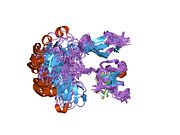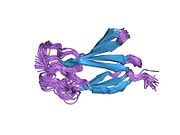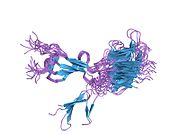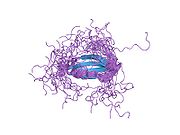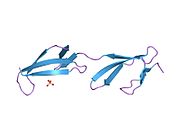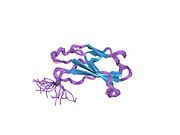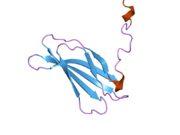Fibronectin
| View/Edit Human | View/Edit Mouse |

Fibronectin is a high-
Fibronectin exists as a
Two types of fibronectin are present in
- soluble plasma fibronectin (formerly called "cold-insoluble globulin", or CIg) is a major protein component of hepatocytes.
- insoluble cellular fibronectin is a major component of the extracellular matrix. It is secreted by various fibroblasts, as a soluble protein dimerand is then assembled into an insoluble matrix in a complex cell-mediated process.
Fibronectin plays a major role in
Structure
Fibronectin exists as a protein dimer, consisting of two nearly identical
Three regions of variable
The modules are arranged into several functional and
Function
Fibronectin has numerous functions that ensure the normal functioning of
Fibronectin plays a crucial role in
Fibronectin is necessary for
Fibronectin is also found in normal human saliva, which helps prevent
Matrix assembly
Fibronectin's shift from
A transmembrane protein, CD93, has been shown to be essential for fibronectin matrix assembly (fibrillogenesis) in human dermal blood endothelial cells.[19] As a consequence, knockdown of CD93 in these cells resulted in the disruption of the fibronectin fibrillogenesis. Moreover, the CD93 knockout mice retinas displayed disrupted fibronectin matrix at the retinal sprouting front.[19]
Role in cancer
Several morphological changes has been observed in
Fibronectin has been implicated in
Fibronectin 1 acts as a potential biomarker for radioresistance[22] and for pan-cancer prognosis.[23]
FN1-FGFR1 fusion is frequent in phosphaturic mesenchymal tumours.[24][25]
Role in wound healing
Fibronectin has profound effects on wound healing, including the formation of proper substratum for migration and growth of cells during the development and organization of granulation tissue, as well as remodeling and resynthesis of the connective tissue matrix.[26] The biological significance of fibronectin in vivo was studied during the mechanism of wound healing.[26] Plasma fibronectin levels are decreased in acute inflammation or following surgical trauma and in patients with disseminated intravascular coagulation.[27]
Fibronectin is located in the extracellular matrix of embryonic and adult tissues (not in the
In vivo vs in vitro
Plasma fibronectin, which is synthesized by
Fibronectin genetic variation as a protective factor against Alzheimer's disease
A specific genetic variation in Fibronectin gene was shown to reduce the risk of developing Alzheimer's disease in a multicenter, multiethnic genetic epidemiology and functional genomics study. This effect is believed to be through enhancing the brain's ability to clear the toxic waste and protein accummulation through blood-brain-barrier. [33]
Interactions
Besides integrin, fibronectin binds to many other host and non-host molecules. For example, it has been shown to interact with proteins such fibrin, tenascin, TNF-α, BMP-1, rotavirus NSP-4, and many fibronectin-binding proteins from bacteria (like FBP-A; FBP-B on the N-terminal domain), as well as the glycosaminoglycan, heparan sulfate.
Fibronectin has been shown to
See also
- Fetal fibronectin
- Fibronectin type I domain
- Fibronectin type II domain
- Fibronectin type III domain
- Monobody, an engineered antibody mimetic based on the structure of the fibronectin type III domain
- Substrate adhesion molecules
References
- ^ a b c GRCh38: Ensembl release 89: ENSG00000115414 – Ensembl, May 2017
- ^ a b c GRCm38: Ensembl release 89: ENSMUSG00000026193 – Ensembl, May 2017
- ^ "Human PubMed Reference:". National Center for Biotechnology Information, U.S. National Library of Medicine.
- ^ "Mouse PubMed Reference:". National Center for Biotechnology Information, U.S. National Library of Medicine.
- PMID 17974429. Archived from the originalon February 9, 2022.
- ^ PMID 12244123.
- PMID 18451144.
- PMID 31819923.
- ^ PMID 16061370.
- ^ Sitterley G. "Fibronectin". Sigma Aldrich.
- S2CID 7052723.
- PMID 9398676.
- S2CID 28645109.
- PMID 15992798.
- PMID 8306876.
- S2CID 2640979.
- PMID 3305363.
- S2CID 16975447.
- ^ PMID 29763414.
- ISBN 978-0-387-97050-9.
- PMID 16397245.
- PMID 20930522.
- PMID 36329531.
- PMID 26759148.
- S2CID 9887919.
- ^ PMID 7240787.
- PMID 1002003.
- PMID 1158872.
- PMID 56335.
- PMID 567240.
- PMID 6339502.
- ^ PMID 6480605.
- PMID 38598053.
- PMID 1730778.
- PMID 7963647.
- PMID 9169408.
- PMID 2531657.
- PMID 12127836.
- PMID 11344214.
- PMID 7499434.
- PMID 18276110.
Further reading
- ffrench-Constant C (December 1995). "Alternative splicing of fibronectin--many different proteins but few different functions". Experimental Cell Research. 221 (2): 261–71. PMID 7493623.
- Snásel J, Pichová I (1997). "The cleavage of host cell proteins by HIV-1 protease". Folia Biologica. 42 (5): 227–30. S2CID 7617882.
- Schor SL, Schor AM (2003). "Phenotypic and genetic alterations in mammary stroma: implications for tumour progression". Breast Cancer Research. 3 (6): 373–9. PMID 11737888.
- Przybysz M, Katnik-Prastowska I (2002). "[Multifunction of fibronectin]" [Multifunction of fibronectin]. Postȩpy Higieny I Medycyny Doświadczalnej (in Polish). 55 (5): 699–713. PMID 11795204.
- Rameshwar P, Oh HS, Yook C, Gascon P, Chang VT (2003). "Substance p-fibronectin-cytokine interactions in myeloproliferative disorders with bone marrow fibrosis". Acta Haematologica. 109 (1): 1–10. S2CID 25830801.
- Cho J, Mosher DF (July 2006). "Role of fibronectin assembly in platelet thrombus formation". Journal of Thrombosis and Haemostasis. 4 (7): 1461–9. S2CID 24109462.
- Schmidt DR, Kao WJ (January 2007). "The interrelated role of fibronectin and interleukin-1 in biomaterial-modulated macrophage function". Biomaterials. 28 (3): 371–82. PMID 16978691.
- Dallas SL, Chen Q, Sivakumar P (2006). Dynamics of assembly and reorganization of extracellular matrix proteins. Vol. 75. pp. 1–24. )
External links
- Fibronectin, an Extracellular Adhesion Molecule
- The Fibronectin Protein Archived March 10, 2022, at the Wayback Machine
- Fibronectin at the U.S. National Library of Medicine Medical Subject Headings (MeSH)
- Fibronectin molecular interactions
- Overview of all the structural information available in the PDB for UniProt: P02751 (Human Fibronectin) at the PDBe-KB.
- Overview of all the structural information available in the PDB for UniProt: P11276 (Mouse Fibronectin) at the PDBe-KB.

